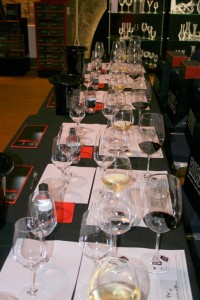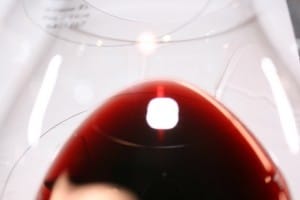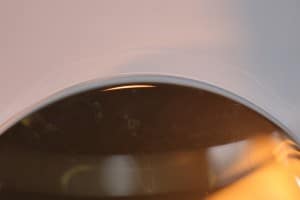I can remember being told years ago that there are basically two schools of thought about the importance of the right glass for individual wines. There are those who think that reaching for the right glass – the size and shape, the quality of glassware and the feel of the stem – is part of the art of wine. And then there are others who say that the only thing that matters is that the glass has a hole at the top and not at the bottom … The Austrian glass-making firm, here represented by CEO Maximillian Riedel, grandson of Georg, has done an amazing job of persuading dedicated wine drinkers of the merits of attention to glassware. There is now a glass for all the world’s main grape varieties, three quality levels of crystal and a range of spectacular decanters to go with your glasses. Probably enough stuff to keep the wine lover in birthday presents for a few years and to lead to one enormous storage problem.
I started this Riedel demonstration as something of a fan. Janet and I have Bordeaux glasses (for claret and most Italian reds, used all the time), red Burgundy (which elevate what should be a great treat anyway), a couple of Grand Cru Chardonnay (not used enough for obvious reasons), Chablis (which do service for most whites and light reds), and Champagne flutes. For the wine group, we have the excellent, all-purpose (sorry Maximillian) Riesling/Sangiovese glass in the tough and inexpensive Restaurant range – how could I not buy a glass named after two of my all-time favourite grape varieties? So it’s quite a modest collection of glasses by Riedel standards, but the joke is still that we had to move house to accommodate the glasses. Having moved we have now filled up again, so we are planning an extension for a new tasting room … Our glasses are all machine-blown. The hand-blown ones are incredibly beautiful but I prefer my bottle of wine to cost more than the glass I am drinking from. But you can’t deny the joy of drinking out of beautiful, fine, glasses and we should try to think about the total wine experience and not segment it. Even the machine-blown glasses are a joy to hold: satisfyingly substantial, a piece of engineering, a thing of translucent beauty. They announce that this drink is something special, to be attended to; it is something to be celebrated, savoured and thought about.
But the big question is: do these glasses really make a difference? The Riedel tasting I attended, on this occasion for invited wine bloggers, was set up to demonstrate this. There were just two main wines, an excellent mature Chardonnay and a Cabernet Sauvignon, both new world. Unusually the actual wine details on this occasion were not the point. Maximillian talked us through the exercise. Swirl, smell, taste, savour … the same wine was tasted first in its dedicated glass, then in a contrasting glass, then in a plastic throw-away beaker (a glass beaker would be better to eliminate the feeling that the plastic makes a difference), then back to the dedicated glass. You can do this at home … in fact it’s better done at home as you can exercise your own judgement in a more neutral space and have the same amount of wine in each glass simultaneously. I was politely but firmly discouraged from splitting my wine between two glasses at this tasting … Riedel is a very powerful brand and Maximillian wanted us to do it his way.
There are two key bits of theory, one which we spend some time on, the other which is implied but is worth stating first:
- The aromas of the wine are released more powerfully if you swirl the glass and there is potential for greater aeration with a good-sized volume of air in the glass. The ‘volumes’ point is made visually – Riedel glasses have been getting bigger in order to do justice to the fruitier, more alcoholic, wines now being produced. The glasses we tasted from were in the Vinum XL range, which is obviously a bigger version of the standard Vinum line. Incidentally, the experienced wine educator I sat next to is of the ‘non swirling’ school of tasters, but that’s another story. It’s a good reminder that virtually every ‘rule’ relating to taste and smell is contested. You simply have to test the rules yourself.
- The shape of the bowl of the glass, particularly as it reaches the rim, affects which parts of your mouth and tongue first meets the wine and therefore your experience of the wine. You can clearly see the different shape of approach in the two glasses below, on the left, the rounded Chardonnay glass and on the right in a new style Pinor Noir glass with a sharp cone of wine. The theory is that that the rounded approach of the Grand Cru Chardonnay glass delivers the wine in a way that avoids the tip of the tongue (sweetness), bringing out the balance of fruit and its acidity. Meanwhile, the Cabernet is best in its own glass which emphasises the sweetness of the fruit; if served in the new style, pointed Pinot Noir glass, you are more aware of the alcohol and the spice but not the fruit.
As it happens, the ‘tongue map’ theory about tasting wine (sweet at the tip of the tongue, bitter at the back, salty and sour at the sides) is itself strongly criticised nowadays, for example, by Linda Bartoshuk of Yale. Critics now say that you can perceive the four tastes anywhere in the mouth where there are taste buds, with the differences being small around the mouth. For a summary by Jordan Ross, click here. Be that as it may, we are there to try the glasses in our experience.
We try the Chardonnay in the various glasses and the results are clear enough. The wine is much more expressive in its Chardonnay glass. In the tall and thin Riesling glass, there are fewer aromatics, with a loss of the creaminess you get in good Chardonnay. In the plastic cup, the wine dies. According to our guide, this is nothing to do with the material the beaker is made from but all to do with its shape and size. Pour the same sample of wine back into the Chardonnay glass and all is restored – it’s like magic. We try the big 15% Cabernet in its designated glass and then in the Pinot Noir shape, then in the rounded Chardonnay glass, then in the much-ridiculed plastic cup. It does taste less balanced in the Pinot glass, drier and more bitter; and rather dumb in the Chardonnay. The powerful fruit does survive the plastic cup but the wine tastes green and tannic. So there are real differences.
Perhaps the most interesting outcome – apart from needing yet more space to store more glasses – is the way that initial perception affects the whole experience. The standard theory is that our ability to smell is far more developed than the four basic ‘tastes’ and that, therefore, what we call taste is really a combination of smell and taste. From this, it would follow that the initial perception of aroma on the nose could affect the taste in the mouth. What was surprising is that the initial perception also appears to affect the aftertaste. This is the case even if you swill the wine around your mouth. I had assumed that the experience of having wine in the mouth would lead to the aftertaste being perceived in the same way irrespective of the glass it had been in. But not so: the initial aroma and the way that the wine initially meets the palate has a real effect not only on the taste in general but on the aftertaste.
This was a fascinating experience of the best sort – that is, it raised more questions than it answered. As usual, the only way forward is more research and, in this case, more research means more glasses and more bottles …






Comments are closed.